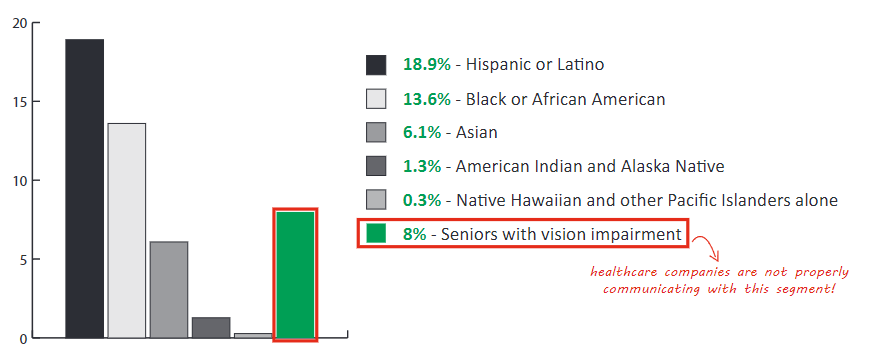Digital accessibility in the healthcare sector is vital for several reasons. Firstly, it enables people with disabilities to access critical healthcare information and services independently. They do not need to depend on assistance from others. Secondly, it promotes better health outcomes for people with disabilities. Since they are more likely to receive timely care when they can access information and services through digital channels.
Ultimately, digital accessibility in healthcare ensures everyone, regardless of their abilities, have equal access to healthcare services and information.
Accessibility ensures the design and development of websites, mobile apps, and other platforms in a way that is inclusive of everyone.
In recent years, the importance of digital accessibility has become increasingly apparent, particularly in the healthcare sector. Companies use digital technologies to deliver medical care and improve patient outcomes.
Digital Accessibility Laws in the Healthcare Sector
Section 1557
Section 1557 of the Affordable Care Act prohibits discrimination on the basis of a variety of different classifications including disabilities. This law mandates that healthcare organizations make their digital resources and electronic communications accessible to people with disabilities.
The United States Department of Health and Human Services (HHS) has proposed revisions to Section 1557 regulations. It prohibits discrimination against people with disabilities in the following areas.
- All HHS programs and activities,
- Health insurance issuers who receive federal financial assistance, and
- Health programs and activities include those services offered via telehealth, which must be accessible to individuals with disabilities.
Centers for Medicare and Medicaid Services
CMS requires its communications to be accessible to all its beneficiaries, regardless of their ability.
Here are some reasons why digital accessibility is crucial in the healthcare sector
Ensuring equal access to healthcare
Accessibility is essential to ensure that individuals with disabilities have equal access to healthcare services. By making digital content accessible, healthcare providers can ensure that all patients can access medical information. They can easily communicate with their healthcare providers, and use digital tools to manage their health.
Improving patient outcomes
Digital accessibility can also improve patient outcomes by enabling individuals with disabilities to access critical health information and resources. For example, individuals with hearing impairments can benefit from captioned videos and audio transcripts. While individuals with visual impairments can benefit from screen readers and alternative text descriptions.
Meeting legal and regulatory requirements
Healthcare providers have to legally comply with the ADA and and the Web Content Accessibility Guidelines (WCAG). Failure to comply with these standards can result in legal and financial consequences. It can also result in damage to a provider’s reputation.
Enhancing patient satisfaction
Patients have improved access to healthcare services in a way that is convenient and comfortable for them. For example, patients with mobility impairments can use telemedicine to receive medical care from the comfort of their own homes. They do not need special transportation or physical accommodations.
Fostering innovation
By prioritizing digital accessibility, healthcare providers can foster innovation and create new opportunities for improving patient care. For example, accessible digital tools monitor patient health, track medication adherence, and provide personalized health recommendations.
Rising Digital Accessibility Lawsuits in the Healthcare Sector
Digital accessibility lawsuits are at an all-time high, and no organization is invulnerable to this trend. This is not going to slow down anytime soon! For example, in 2022, more than 3,000 organizations endured accessibility-related lawsuits for compliance violations.
The legal precedent favors digital accessibility, resulting in litigation against thousands of organizations—including many in the healthcare sector. Examples include the following cases:
- On October 25, 2021, Cheryl Thurston filed a complaint against K Health, Inc., alleging that their website was inaccessible. K Health is a Helath Care Providers and Services Company founded in 2016 and headquartered in New York.
- On September 14, 2021, Brittney Mejico filed a complaint against WCG Health Management, Inc., alleging that their website is inaccessible. The company has headquarters in Tampa, Florida.
What’s happening now?
In recent times, there has been an increased emphasis on diversity, equity, and inclusion (DEI) in the healthcare sector. Healthcare companies cater to their diverse subscribers from different nationalities by translating their digital healthcare communications into different languages.
However, by ignoring their largest constituents – subscribers with vision impairments – healthcare companies are excluding people with disabilities. They are not providing this segment of the population with accessible communication.
Who is left out to engage with your healthcare communications?
Healthcare companies approach diversity by translating communications into different languages based on ethnicity.

20M seniors with vision impairments do not have access to healthcare communications. This includes people with vision loss, macular degeneration, diabetic retinopathy, etc.
According to the CDC,
- Approximately 8% million people 40 years and over in the United States have vision impairment
- Vision disability is one of the top 10 disabilities among adults 18 years and older
codemantra Digital Accessibility for Healthcare Sector
codemantra’s digital accessibility solutions can make any medical electronic documents accessible as per Section 1557 of the Affordable Care Act.
Our AI-powered platform offers unique features such as making fillable medical forms accessible, remediating output in five different languages (Chinese Traditional, Spanish, Arabic, Urdu, and French).
We offer AI-powered technologies that help healthcare organizations to conform to Section 1557 and the CMS standards. So, don’t hesitate. Reach out to us today!
You can also contact us with your queries via the form below.







